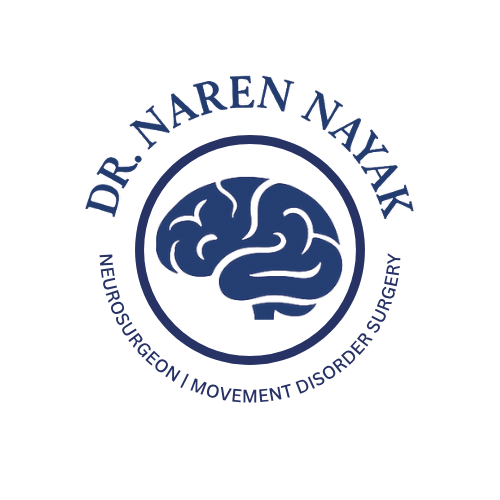Meet Dr. Naren Nayak

Dr. Naren Nayak, regarded as the best neurosurgeon in Thane, has dedicated over 15 years to the demanding field of brain surgery. With advanced training in India and a fellowship in Functional Neurosurgery in Japan, he has built expertise in treating some of the most challenging neurological conditions, including complex brain tumors, movement disorders, and critical head injuries.
Further trauma training at NIMHANS, Bengaluru, strengthened his skills in managing life‑threatening neurological emergencies. Over the years, he has performed a wide spectrum of intricate surgeries with precision and steadiness, earning the trust of patients and peers alike.

Beyond the operating room, Dr. Naren Nayak’s role as a professor of neurosurgery reflects his commitment to advancing the field. He is actively involved in mentoring young surgeons, contributing to research, and ensuring that patients benefit from the latest innovations in neurosurgery. This balance of hands-on expertise and commitment to knowledge makes him one of the most sought-after names in advanced neurosurgical care.
Co-Founder of DBS Program

In 2015, Dr. Naren Nayak co‑founded the Deep Brain Stimulation (DBS) program at Gleneagles Hospital, Parel—one of the most advanced treatments available for movement disorders. This program opened doors for patients with Parkinson’s disease, essential tremors, and dystonia who had reached a stage where medicines no longer gave relief.
Through DBS, fine electrodes are placed in precise areas of the brain to restore control over movements, reduce tremors and stiffness, and allow patients to return to everyday activities with dignity. Over the years, Dr. Naren Nayak’s work in this field has transformed the lives of many individuals and their families, giving them hope where options seemed limited.

Know Dr. Naren Nayak at a Glance
Qualifications
- MBBS – Seth G.S. Medical College & K.E.M. Hospital, Mumbai
- MS in General Surgery – PGIMER, Chandigarh
- M.Ch. in Neurosurgery – SCTIMST, Trivandrum
- Fellowship in Stereotactic & Functional Neurosurgery – Tokyo Women’s Medical University, Japan
- Specialized training in trauma care – NIMHANS, Bengaluru
Experience
- Additional Professor in Neurosurgery – Lokmanya Tilak Municipal Medical College, Mumbai (Aug 2022 – Present)
- Associate Professor in Neurosurgery (2019 – 2022)
- Assistant Professor in Neurosurgery (2009 – 2019)
- Senior Registrar in Neurosurgery – performed 150+ emergency brain surgeries
- During his tenure at Lokmanya Tilak Municipal Medical College, Mumbai (2009–2019), he independently performed over 500 brain and spine surgeries and assisted in more than 400 advanced procedures involving deep brain and vascular cases.
Memberships
- Neurological Society of India
- Neuro Spinal Surgeons Association of India
- AO Spine Asia Pacific
Here’s a look at the advanced procedures that Dr. Naren Nayak, a seasoned neurosurgeon in Thane, specializes in.
Specialist for
Surgery for Movement Disorders
MR-guided Focused Ultrasound (MRgFUS): Non-invasive ultrasound technique to stop tremors without open surgery.
Pallidotomy: Creating a precise lesion in the brain to improve movement in Parkinson’s disease and dystonia.

Surgery for Intracranial Bleeding

Surgery for Brain Tumor
Safe and advanced surgical removal of tumors while preserving vital brain functions.

Trigeminal Neuralgia Surgery
Procedures such as microvascular decompression or lesioning to relieve severe facial pain.
Stereotactic Biopsy
Minimally invasive biopsy using image guidance to diagnose deep-seated brain lesions.
Publications
- Ruptured Fenestrated A1 Segment Aneurysm – Case report & literature review (Cureus, 2024)
- Isolated Spinal Extradural AML in Children – Rare cause of cord compression (J Pediatr Neurosci, 2023)
- Melanocytic Melanoma at Foramen Magnum – Unusual spinal tumor (J Spinal Surg, 2023)
- Juvenile PLA2G6-Parkinsonism & DBS Outcome – Genetic case study (Mov Disord, 2022)
- Posthemorrhagic Hydrocephalus Management – Comprehensive review (Neurol India, 2021)
- Subcutaneous CSF Pseudocyst – Shunt-related complication (J Neurosci Rural Pract, 2019)
- Craniovertebral Arachnoid Cyst in Elderly – Extremely rare case (World Neurosurg, 2019)
- Spinal Epidural Tubercular + Pyogenic Abscess – Without bony involvement (J Neurosci Rural Pract, 2019)
- Intramedullary Cystic Teratoma with Dermal Sinus – Pediatric case (J Neurosci Rural Pract, 2018)
- Giant Tentorial Xanthogranuloma in Adult – Rare symptomatic lesion (Br J Neurosurg, 2011)
Frequently Asked Questions
What makes a neurosurgeon different from a neurologist?
A neurologist diagnoses and treats conditions with medicines and non-surgical approaches, while a neurosurgeon is trained to perform surgeries when structural problems in the brain, spine or nerves require intervention.
What percentage of patients benefit from Deep Brain Stimulation (DBS)?
Studies show that more than 70% of well-selected patients with Parkinson’s disease or tremor disorders experience significant improvement in symptoms and quality of life after DBS.
Can a patient return to normal activities after neurosurgery?
With proper recovery and rehabilitation, most patients gradually return to daily activities. The time taken depends on the type of surgery and overall health.
How long does a typical brain surgery take?
The duration depends on the type of surgery. Some minimally invasive procedures may take 2–3 hours, while complex surgeries can take 6–8 hours or longer. Each case is planned in detail beforehand.
How safe are modern brain and spine surgeries?
With advanced imaging, navigation systems and microsurgical techniques, the risk during brain and spine surgeries has significantly reduced. Safety protocols are followed at every step to ensure the best possible outcome.
